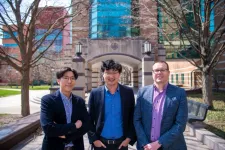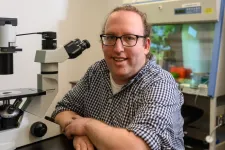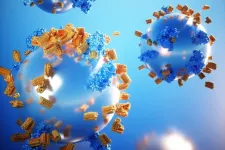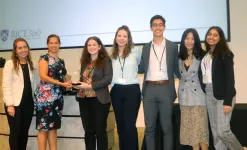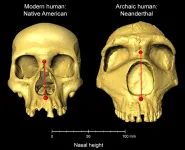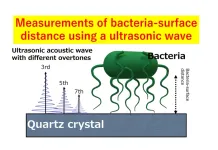(Press-News.org) Recognizing and separating enantiomers is a difficult task for chemical engineers — one might say it gives them a bit of a headache.
Enantiomers are molecules with virtually identical compositions that mirror one another, like a left and right hand. In chemistry, this property is called chirality. Despite the similarities in their makeup, so-called left- and right-handed enantiomers often exhibit very different properties. Sometimes a drug has an enantiomer that causes undesirable effects. For example, certain drugs have one enantiomer that can cause a headache, while the other provides relief.
More than half of the top 500 drugs used in the United States are enantiomeric, according to Xiao Su, a researcher at the Beckman Institute for Advanced Science and Technology and an assistant professor of chemical and biomolecular engineering at the University of Illinois Urbana-Champaign. Su, alongside UIUC doctoral student Jemin Jeon and research scientist Johannes Elbert, recently developed a system to electrochemically distinguish one enantiomer from its twin.
The group’s development has significant implications for the drug manufacturing industry. Because new drugs are typically required to be racemic —containing an even 50-50 mixture of left- and right-handed enantiomers — their system would allow drug developers to more easily determine the ratio of enantiomers in a given drug, and eventually lead to more effective methods of separating them.
“When you’re producing a drug, you want to know how much of each enantiomer is in there,” Elbert said. “It’s like a form of quality control.”
Their paper appears in Advanced Functional Materials.
To effectively distinguish one enantiomer from its mirrored counterpart, the researchers used a versatile class of metal-containing polymers, also referred to as “metallopolymers,” that have been used for energy storage, water treatment, and selective separations. Historically, these metallopolymers have seen limited use for enantiomer recognition because they usually lack chirality, or handedness.
By adding a chiral center to the metallopolymers, researchers can use them to electrochemically sense two enantiomeric molecules: for example, the molecules used in valuable pharmaceuticals.
“The cool scientific advance here is that we’re able to prove that these redox polymers with chirality can be very good sensors and interact with their preferred enantiomers,” Su said.
Enantiomer recognition begins with chemically designed building blocks on the polymer, referred to as “redox-centers.” Redox-centers allow the polymers to undergo reduction and oxidation (hence the polymers’ portmanteau name) by electron transfer. This process allows the redox-centers from the polymers to selectivity bind, and thus sense, an enantiomer by changes in current and potential.
“We’ve basically created a class of chiral metallopolymers that can serve as platform for many enantioselective studies going forward,” Su said.
Furthermore, the study shows for the first time a phenomenon referred to as supramolecular chirality, an intriguing feature in which the polymer displays more chirality than the redox-center building blocks themselves. The researchers leverage this supramolecular chirality to amplify the sensing effect, an efficient upgrade from past sensing methods.
“With electrochemical methods, there’s no need to add anything external like chemical additives,” Su said. “It’s a sensing method purely based on electrical input and electrical readouts, making it flexible and modular to use.”
Although studies on chiral sensors already exist, many are limited to one-time use. But the Illinois researchers’ sensor is mobilized onto an interface, allowing it to be reused.
And while their newly developed sensor method is still considered proof of concept, the researchers have already identified their next steps.
“Now that we have proved the sensing and recognition properties, the next step is to translate these properties for separation” Su said. “Right now our system works really well for chiral sensing, but beyond that, we want to create devices and even better materials to be able to fully purify enantiomers.”
The paper titled "Chiral Metallopolymers for Redox-Mediated Enantioselective Interactions" can be accessed online at https://doi.org/10.1002/adfm.202301545
Media contact: Jenna Kurtzweil, kurtzwe2@illinois.edu
END
Mirror, mirror: A new way to recognize reverse-image molecules
Researchers from the Beckman Institute for Advanced Science and Technology have developed a modular method of recognizing chiral molecules.
2023-05-08
ELSE PRESS RELEASES FROM THIS DATE:
Experimental model gets cells to behave as they would in utero
2023-05-08
HOUSTON – (May 8, 2023) – Many birth defects and spontaneous abortions occur during the embryonic development stage known as neurulation, yet we have very little insight into how this critical developmental process unfolds in humans.
The Rice University lab of Aryeh Warmflash has received a five-year, $1.9 million grant from the National Institutes of Health to optimize and develop experimental cell models that can shed light on the self-organizing processes by which ectodermal ...
U of M researchers develop technique for rapid detection of neurodegenerative diseases like Parkinson’s and Chronic Wasting Disease
2023-05-08
University of Minnesota Twin Cities researchers have developed a groundbreaking new diagnostic technique that will allow for faster and more accurate detection of neurodegenerative diseases. The method will likely open a door for earlier treatment and mitigation of various diseases that affect humans, such as Alzheimer's and Parkinson's, and similar diseases that affect animals, such as chronic wasting disease (CWD).
Their new study is published in Nano Letters, a premier journal in the field of nanotechnology published by the American Chemical Society.
“This paper mainly ...
Rice University students design congenital hypothyroidism test for newborns
2023-05-08
HOUSTON – (May 8, 2023) – For newborns with congenital hypothyroidism, early diagnosis spells the difference between a normal, healthy life and lifelong disability.
After learning about the heavy toll the disease takes on children born in parts of the world where testing is limited or absent, a team of Rice University students came together to develop a low-cost screening tool that can detect abnormally high thyroid-stimulating hormone (TSH) levels indicative of dysfunction.
The point-of-care, paper-based test developed ...
Culture, diet, economic factors and more affect CVD risk among Asian Americans
2023-05-08
Statement Highlights:
Health research that considers Asian Americans as a single race and ethnic group may result in over- or under-estimating the risk of Type 2 diabetes and cardiovascular disease among people of diverse Asian American subgroups, by geographic region of descent.
Together, cardiovascular disease and Type 2 diabetes are the leading causes of death and disease in Asian American adults, however, rates vary widely among subgroups. For example, the latest data on the prevalence of Type 2 diabetes in Asian American adults, ages 45-84, reveals a range of Type ...
Nose shape gene inherited from Neanderthals
2023-05-08
Humans inherited genetic material from Neanderthals that affects the shape of our noses, finds a new study led by UCL researchers.
The new Communications Biology study finds that a particular gene, which leads to a taller nose (from top to bottom), may have been the product of natural selection as ancient humans adapted to colder climates after leaving Africa.
Co-corresponding author Dr Kaustubh Adhikari (UCL Genetics, Evolution & Environment and The Open University) said: “In the last 15 years, since the Neanderthal genome ...
Immunotherapy plus chemotherapy combination for advanced lung cancer not only prolongs life but also improves its quality
2023-05-08
A recent clinical trial showed that the drug combination of cemiplimab plus platinum chemotherapy can prolong survival in patients with advanced lung cancer when compared with placebo plus platinum chemotherapy. Now an analysis published by Wiley online in CANCER, a peer-reviewed journal of the American Cancer Society, indicates that cemiplimab plus platinum chemotherapy also affects quality of life compared to chemotherapy alone.
The multinational phase 3 EMPOWER-Lung 3 trial had shown that the addition ...
Organoids derived from patient tissues support personalized cancer treatment
2023-05-08
Chicago (May 2, 2023) — Researchers created organoids from cancer cells to reduce the need for trial and error in identifying effective cancer treatments in one of many cancer studies scheduled for presentation this week at Digestive Disease Week® (DDW) 2023.
Below are summaries of three studies scheduled for DDW, their embargo times and presentation times at the meeting in Chicago May 6-9.
Personalized drug screening in patient-derived organoids of biliary tract cancer and its clinical application
Chemotherapy is often the only treatment option for biliary tract cancer, which is usually found at a late stage, making it one of the most lethal ...
Cognitive behavioral therapy lessens post-viral fatigue after COVID-19
2023-05-08
Those with post-viral fatigue after suffering from COVID-19 benefit from cognitive behavioural therapy, resulting in less fatigue and concentration problems. Lead researcher, Hans Knoop, Professor of Medical Psychology at Amsterdam UMC found that “After behavioural therapy, patients not only had less symptoms but also functioned better both physically and socially. Those improvements were still present even after six months.” Today, research from Amsterdam UMC, RadboudUMC and three other hospitals is published in Clinical Infectious Diseases.
After a COVID-19 infection, a substantial number of patients report persisting symptoms. This is often known as long-COVID or ...
Examining the adhesion tendency of biofilm-forming bacteria on organic surfaces
2023-05-08
The biofilm-forming bacteria E. coli adheres firmly to hydrophobic and hydrophilic protein-adsorbing self-assembling monolayers (SAMs) and weakly to hydrophilic protein-resisting SAMs, uncovered a recent study by Tokyo Tech researchers. These findings on how surface chemistry can influence the adhesion of bacterial cells and, in turn, biofilm formation could open doors to bacteria-resistant surfaces and antibiofouling coatings for biomedical and industrial devices.
Bacterial biofilms are like a double-edged sword. On one hand, they have proven valuable ...
New decision aid to help with screening to prevent fragility fractures
2023-05-08
Should healthy people be screened to help reduce their risk of fragility fractures? A new interactive online Fragility Fracture Decision Aid for shared decision-making can help clinicians and patients visualize their individual risk of fracture and the potential benefits and harms of preventive treatment.
The decision aid is part of a new guideline https://www.cmaj.ca/lookup/doi/10.1503/cmaj.221219 from the Canadian Task Force on Preventive Health Care on screening to prevent fragility fractures. The guideline, ...
LAST 30 PRESS RELEASES:
Flaring black hole whips up ultra-fast winds
Study explores the link between newspaper preference and attitudes towards autism
Artificial turf in the Nordic climate – a question of sustainability
The hidden toll of substance use disorder: annual cost of lost productivity to US economy nearly $93 billion
Among psychologists, AI use is up, but so are concerns
Recycling a pollutant to make ammonia production greener
Common institutional ownership linked to less aggressive business strategies in Chinese firms
Energy and regional factors drive carbon price volatility in China’s emissions trading markets
Researchers from NUS Medicine and the Institute of Mental Health detect early brain changes linked to future psychosis development
Cryopreserved vs liquid-stored platelets for the treatment of surgical bleeding
Cost-effectiveness of cryopreserved vs liquid-stored platelets for managing surgical bleeding
Adaptive Kalman filter boosts BDS-3 navigation accuracy in challenging environments
Home-based monitoring could transform care for patients receiving T-cell redirecting therapies
Listening to the 'whispers' of electrons and crystals: A quantum discovery
Report on academic exchange (colloquium) with Mapua University
Sport in middle childhood can breed respect for authority in adolescence
From novel therapies to first-in-human trials, City of Hope advances blood cancer care at the American Society of Hematology (ASH) annual conference
Research aims to strengthen the security of in-person voting machines
New study exposes hidden Alzheimer’s 'hot spots' in rural Maryland and what they reveal about America’s growing healthcare divide
ASH 2025: Study connects Agent Orange exposure to earlier and more severe cases of myelodysplastic syndrome
ASH 2025: New data highlights promise of pivekimab sunirine in two aggressive blood cancers
IADR elects George Belibasakis as vice-president
Expanding the search for quantum-ready 2D materials
White paper on leadership opportunities for AI to increase employee value released by University of Phoenix College of Doctoral Studies
ASH 2025: New combination approach aims to make CAR T more durable in lymphoma
‘Ready-made’ T-cell gene therapy tackles ‘incurable’ T-cell leukemia
How brain activity changes throughout the day
Australian scientists reveal new genetic risk for severe macular degeneration
GLP-1 receptor agonists likely have little or no effect on obesity-related cancer risk
Precision immunotherapy to improve sepsis outcomes
[Press-News.org] Mirror, mirror: A new way to recognize reverse-image moleculesResearchers from the Beckman Institute for Advanced Science and Technology have developed a modular method of recognizing chiral molecules.
